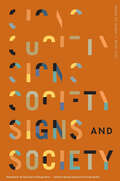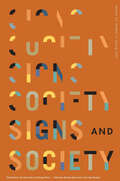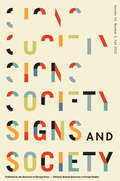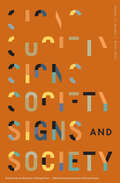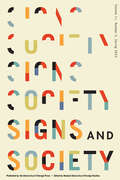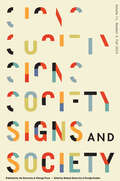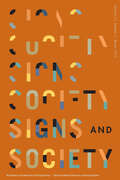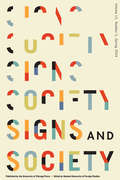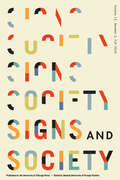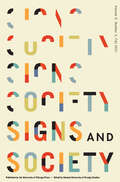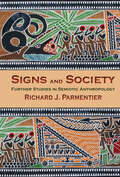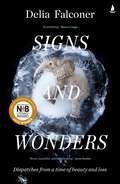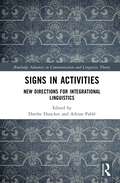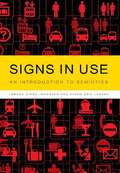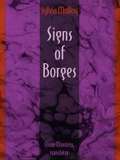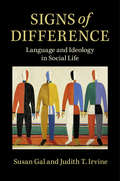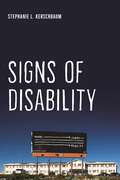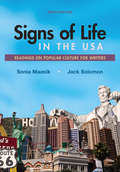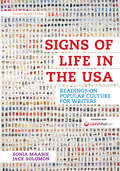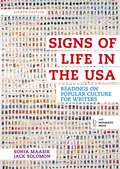- Table View
- List View
Signs and Society, volume 10 number 1 (Winter 2022)
by Signs and SocietyThis is volume 10 issue 1 of Signs and Society. Signs and Society is an open-access, multidisciplinary journal in the humanities and social sciences focusing on research that examines the role of sign processes (or semiosis) in social interaction, cognition, and cultural formations. Focusing directly on semiosis in its multiple dimensions, the journal aims to promote collaborative translation across analytical categories and technical vocabularies already established in anthropology, linguistics, semiotics, and related disciplines, and to uncover unanticipated parallels in the ways semiosis is manifest in diverse empirical domains.
Signs and Society, volume 10 number 2 (Spring 2022)
by Signs and SocietyThis is volume 10 issue 2 of Signs and Society. Signs and Society is an open-access, multidisciplinary journal in the humanities and social sciences focusing on research that examines the role of sign processes (or semiosis) in social interaction, cognition, and cultural formations. Focusing directly on semiosis in its multiple dimensions, the journal aims to promote collaborative translation across analytical categories and technical vocabularies already established in anthropology, linguistics, semiotics, and related disciplines, and to uncover unanticipated parallels in the ways semiosis is manifest in diverse empirical domains.
Signs and Society, volume 10 number 3 (Fall 2022)
by Signs and SocietyThis is volume 10 issue 3 of Signs and Society. Signs and Society is an open-access, multidisciplinary journal in the humanities and social sciences focusing on research that examines the role of sign processes (or semiosis) in social interaction, cognition, and cultural formations. Focusing directly on semiosis in its multiple dimensions, the journal aims to promote collaborative translation across analytical categories and technical vocabularies already established in anthropology, linguistics, semiotics, and related disciplines, and to uncover unanticipated parallels in the ways semiosis is manifest in diverse empirical domains.
Signs and Society, volume 11 number 1 (Winter 2023)
by Signs and SocietyThis is volume 11 issue 1 of Signs and Society. Signs and Society is an open-access, multidisciplinary journal in the humanities and social sciences focusing on research that examines the role of sign processes (or semiosis) in social interaction, cognition, and cultural formations. Focusing directly on semiosis in its multiple dimensions, the journal aims to promote collaborative translation across analytical categories and technical vocabularies already established in anthropology, linguistics, semiotics, and related disciplines, and to uncover unanticipated parallels in the ways semiosis is manifest in diverse empirical domains.
Signs and Society, volume 11 number 2 (Spring 2023)
by Signs and SocietyThis is volume 11 issue 2 of Signs and Society. Signs and Society is an open-access, multidisciplinary journal in the humanities and social sciences focusing on research that examines the role of sign processes (or semiosis) in social interaction, cognition, and cultural formations. Focusing directly on semiosis in its multiple dimensions, the journal aims to promote collaborative translation across analytical categories and technical vocabularies already established in anthropology, linguistics, semiotics, and related disciplines, and to uncover unanticipated parallels in the ways semiosis is manifest in diverse empirical domains.
Signs and Society, volume 11 number 3 (Fall 2023)
by Signs and SocietyThis is volume 11 issue 3 of Signs and Society. Signs and Society is an open-access, multidisciplinary journal in the humanities and social sciences focusing on research that examines the role of sign processes (or semiosis) in social interaction, cognition, and cultural formations. Focusing directly on semiosis in its multiple dimensions, the journal aims to promote collaborative translation across analytical categories and technical vocabularies already established in anthropology, linguistics, semiotics, and related disciplines, and to uncover unanticipated parallels in the ways semiosis is manifest in diverse empirical domains.
Signs and Society, volume 12 number 1 (Winter 2024)
by Signs and SocietyThis is volume 12 issue 1 of Signs and Society. Signs and Society is an open-access, multidisciplinary journal in the humanities and social sciences focusing on research that examines the role of sign processes (or semiosis) in social interaction, cognition, and cultural formations. Focusing directly on semiosis in its multiple dimensions, the journal aims to promote collaborative translation across analytical categories and technical vocabularies already established in anthropology, linguistics, semiotics, and related disciplines, and to uncover unanticipated parallels in the ways semiosis is manifest in diverse empirical domains.
Signs and Society, volume 12 number 2 (Spring 2024)
by Signs and SocietyThis is volume 12 issue 2 of Signs and Society. Signs and Society is an open-access, multidisciplinary journal in the humanities and social sciences focusing on research that examines the role of sign processes (or semiosis) in social interaction, cognition, and cultural formations. Focusing directly on semiosis in its multiple dimensions, the journal aims to promote collaborative translation across analytical categories and technical vocabularies already established in anthropology, linguistics, semiotics, and related disciplines, and to uncover unanticipated parallels in the ways semiosis is manifest in diverse empirical domains.
Signs and Society, volume 12 number 3 (Fall 2024)
by Signs and SocietyThis is volume 12 issue 3 of Signs and Society. Signs and Society is an open-access, multidisciplinary journal in the humanities and social sciences focusing on research that examines the role of sign processes (or semiosis) in social interaction, cognition, and cultural formations. Focusing directly on semiosis in its multiple dimensions, the journal aims to promote collaborative translation across analytical categories and technical vocabularies already established in anthropology, linguistics, semiotics, and related disciplines, and to uncover unanticipated parallels in the ways semiosis is manifest in diverse empirical domains.
Signs and Society, volume 9 number 3 (Fall 2021)
by Signs and SocietyThis is volume 9 issue 3 of Signs and Society. Signs and Society is an open-access, multidisciplinary journal in the humanities and social sciences focusing on research that examines the role of sign processes (or semiosis) in social interaction, cognition, and cultural formations. Focusing directly on semiosis in its multiple dimensions, the journal aims to promote collaborative translation across analytical categories and technical vocabularies already established in anthropology, linguistics, semiotics, and related disciplines, and to uncover unanticipated parallels in the ways semiosis is manifest in diverse empirical domains.
Signs and Society: Further Studies in Semiotic Anthropology
by Richard J. ParmentierA major voice in contemporary semiotic theory offers a new perspective on potent intersections of semiotic and linguistic anthropology.In Signs and Society, noted anthropologist Richard J. Parmentier demonstrates how an appreciation of signs helps us better understand human agency, meaning, and creativity. Inspired by the foundational work of C. S. Peirce and Ferdinand de Saussure, and drawing upon key insights from neighboring scholarly fields, Parmentier develops an array of innovative conceptual tools for ethnographic, historical, and literary research.Parmentier’s concepts of “transactional value,” “metapragmatic interpretant,” and “circle of semiosis,” for example, illuminate the foundations and effects of such diverse cultural forms and practices as economic exchanges on the Pacific island of Palau, Pindar’s Victory Odes in ancient Greece, and material representations of transcendence in ancient Egypt and medieval Christianity.Other studies complicate the separation of emic and etic analytical models for such cultural domains as religion, economic value, and semiotic ideology. Provocative and absorbing, these fifteen pioneering essays blaze a trail into anthropology’s future while remaining firmly rooted in its celebrated past.
Signs and Symptoms: Thomas Pynchon and the Contemporary World
by Peter L. CooperThis title is part of UC Press's Voices Revived program, which commemorates University of California Press’s mission to seek out and cultivate the brightest minds and give them voice, reach, and impact. Drawing on a backlist dating to 1893, Voices Revived makes high-quality, peer-reviewed scholarship accessible once again using print-on-demand technology. This title was originally published in 1983.
Signs and Wonders: Dispatches from a time of beauty and loss
by Delia FalconerThe celebrated, Walkley Award-winning author on how global warming is changing not only our climate but our culture. Beautifully observed, brilliantly argued and deeply felt, these essays show that our emotions, our art, our relationships with the generations around us – all the delicate networks that make us who we are – have already been transformed. In Signs and Wonders, Falconer explores how it feels to live as a reader, a writer, a lover of nature and a mother of small children in an era of profound ecological change. Building on Falconer&’s two acclaimed essays, &‘Signs and Wonders&’ and the Walkley Award-winning &‘The Opposite of Glamour&’, Signs and Wonders is a pioneering examination of how we are changing our culture, language and imaginations along with our climate. Is a mammoth emerging from the permafrost beautiful or terrifying? How is our imagination affected when something that used to be ordinary – like a car windscreen smeared with insects – becomes unimaginable? What can the disappearance of the paragraph from much contemporary writing tell us about what&’s happening in the modern mind? Scientists write about a 'great acceleration' in human impact on the natural world. Signs and Wonders shows that we are also in a period of profound cultural acceleration, which is just as dynamic, strange, extreme and, sometimes, beautiful. Ranging from an &‘unnatural&’ history of coal to the effect of a large fur seal turning up in the park below her apartment, this book is a searching and poetic examination of the ways we are thinking about how, and why, to live now. &‘Only the finest of writers can hope to convey the mercurial nature of the times we are living though: the sense of slippage; of terror and beauty. Falconer is such a writer. Signs and Wonders is an essential collection.&’ Sophie Cunningham, author of City of Trees &‘Delia Falconer is one of the best writers working today, and in Signs and Wonders she demonstrates everything that makes her writing so necessary. Brave, beautiful, and breathtaking in its elegance and intelligence, it is, quite simply, a marvel.&’ James Bradley &‘Scintillating. Delia Falconer is at the peak of her powers as a critic, and as an observer of the natural world. Signs and Wonders looks outward from Sydney, and from literature, to trace the contours of our environmental moment.&’ Rebecca Giggs, author of Fathoms
Signs in Activities: New Directions for Integrational Linguistics (Routledge Advances in Communication and Linguistic Theory)
by Dorthe Duncker Adrian PabléThis book is a collective volume bringing together scholars who share an interest in linguistics from an integrational point of view and in developing new directions for future scholarship.Integrational linguistics invites us to rethink the theoretical and methodological premises of general linguistics by drawing on a different conception of the sign and by recognizing the creativity that human communication requires. Some chapters are concerned with concepts like the sign, contextualization, activity, and integration. Although being core concepts developed by the founder of integrational linguistics, Roy Harris, they have arguably remained underdeveloped in Harris’ writings and thus call for further clarification and investigation. Other chapters are concerned with the notions of the self and the social, experience and interaction, with questions about individual agency and will, and human sociality and social organization, which all occupy a central position in integrational theory. Finally, remaining chapters focus on how scriptism and the language myth have influenced our way of thinking about communication in a broad sense.This edited collection will be of interest to a multidisciplinary readership comprising those engaged in study, teaching, and research in the humanities and social sciences, including anthropology, the arts, education, linguistics, literary studies, philosophy, psychology, and semiotics.
Signs in Use: An Introduction to Semiotics
by Jørgen Dines Johansen Svend Erik LarsenSigns in Use is an accessible introduction to the study of semiotics.All organisms, from bees to computer networks, create signs, communicate, and exchange information. The field of semiotics explores the ways in which we use these signs to make inferences about the nature of the world.Signs in Use cuts across different semiotic schools to introduce six basic concepts which present semiotics as a theory and a set of analytical tools: code, sign, discourse, action, text, and culture. Moving from the most simple to the most complex concept, the book gradually widens the semiotic perspective to show how and why semiotics works as it does.Each chapter covers a problem encountered in semiotics and explores the key concepts and relevant notions found in the various theories of semiotics. Chapters build gradually on knowledge gained, and can also be used as self-contained units for study when supported by the extensive glossary. The book is illustrated with numerous examples, from traffic systems to urban parks, and offers useful biographies of key twentieth-century semioticians.
Signs of Being
by C.T. PerezSigns of Being is a collection of poetry, prose, and commentary born from the insights, observations, and experiences of C.T. Perez to understand the realms of CHamoru cultural identity. This work aims to articulate the mindscape of an indigenous CHamoru consciousness through ec(h)o literature: literature that interprets signs in the natural environment as echoes from ancestors. Guided by her saina, or elders, Perez invites readers to join her on a journey through the complexities and intricacies of identity, heritage, memory, and place.
Signs of Borges
by Sylvia Molloy Oscar MonteroAvailable for the first time in English, Signs of Borges is widely regarded as the best single book on the work of Jorge Luis Borges. With a critical sensibility informed by Barthes, Lacan, Foucault, Blanchot, and the entire body of Borges scholarship, Sylvia Molloy explores the problem of meaning in Borges's work by remaining true to the uncanniness that is its foundation.Borges's sustained practice of the uncanny gives rise in his texts to endless tensions between illusion and meaning, and to the competing desires for fragmentation, dispersal, and stability. Molloy traces the movement of Borges's own writing by repeatedly spanning the boundaries of genre and cutting across the conventional separations of narrative, lyric and essay, fact and fiction. Rather than seeking to resolve the tensions and conflicts, she preserves and develops them, thereby maintaining the potential of these texts to disturb. At the site of these tensions, Molloy locates the play between meaning and meaninglessness that occurs in Borges's texts. From this vantage point his strategies of deception, recourse to simulacra, inquisitorial urge to unsettle binarism, and distrust of the permanent--all that makes Borges Borges--are examined with unmatched skill and acuity.Elegantly written and translated, Signs of Borges presents a remarkable and dynamic view of one of the most international and compelling writers of this century. It will be of great interest to all students of twentieth-century literature, particularly to students of Latin American literature.
Signs of Cherokee Culture
by Margaret BenderBased on extensive fieldwork in the community of the Eastern Band of Cherokee Indians in western North Carolina, this book uses a semiotic approach to investigate the historic and contemporary role of the Sequoyan syllabary--the written system for representing the sounds of the Cherokee language--in Eastern Cherokee life. The Cherokee syllabary was invented in the 1820s by the respected Cherokee Sequoyah. The syllabary quickly replaced alternative writing systems for Cherokee and was reportedly in widespread use by the mid-nineteenth century. After that, literacy in Cherokee declined, except in specialized religious contexts. But as Bender shows, recent interest in cultural revitalization among the Cherokees has increased the use of the syllabary in education, publications, and even signage. Bender also explores the role played by the syllabary within the ever more important context of tourism. (The Eastern Cherokee Band hosts millions of visitors each year in the Great Smoky Mountains.) English is the predominant language used in the Cherokee community, but Bender shows how the syllabary is used in special and subtle ways that help to shape a shared cultural and linguistic identity among the Cherokees. Signs of Cherokee Culture thus makes an important contribution to the ethnographic literature on culturally specific literacies.
Signs of Civilisation: How punctuation changed history
by Bård Borch Michalsen'Punctuation is not only an important part of our language code; an advanced system of punctuation has been a driving force in our entire Western Civilisation. Nothing less.'With the invention of printing, reading books moved from being an act only performed by priests and aristocrats into an individual, even private, activity. This change helped spark the Renaissance, the Reformation, the Enlightenment and the Industrial Revolution - in which punctuation played a crucial role. As long as texts were read out loud only by an educated elite there was no need for punctuation to mark pauses, full stops or questions.So punctuation - the full stop, the comma, the exclamation mark, the question mark and the semicolon - helped shape modern-day Europe as we know it.
Signs of Civilisation: How punctuation changed history
by Bård Borch Michalsen'Punctuation is not only an important part of our language code; an advanced system of punctuation has been a driving force in our entire Western Civilisation. Nothing less.'With the invention of printing, reading books moved from being an act only performed by priests and aristocrats into an individual, even private, activity. This change helped spark the Renaissance, the Reformation, the Enlightenment and the Industrial Revolution - in which punctuation played a crucial role. As long as texts were read out loud only by an educated elite there was no need for punctuation to mark pauses, full stops or questions.So punctuation - the full stop, the comma, the exclamation mark, the question mark and the semicolon - helped shape modern-day Europe as we know it.
Signs of Difference: Language and Ideology in Social Life
by Susan Gal Judith T. IrvineHow are peoples' ideas about languages, ways of speaking and expressive styles shaped by their social positions and values? How is difference, in language and in social life, made - and unmade? How and why are some differences persuasive as the basis for action, while other differences are ignored or erased? Written by two recognised authorities on language and culture, this book argues that ideological work of all kinds is fundamentally communicative, and that social positions, projects and historical moments influence, and are influenced by, people's ideas about communicative practices. Neither true nor false, ideologies are positioned and partial visions of the world, relying on comparison and perspective; they exploit differences in expressive features - linguistic and otherwise - to construct convincing stereotypes of people, spaces and activities. Using detailed ethnographic, historical and contemporary examples, this outstanding book shows readers how to analyse ideological work semiotically.
Signs of Disability (Crip #4)
by Stephanie L. KerschbaumHow can we learn to notice the signs of disability?We see indications of disability everywhere: yellow diamond-shaped “deaf person in area” road signs, the telltale shapes of hearing aids, or white-tipped canes sweeping across footpaths. But even though the signs are ubiquitous, Stephanie L. Kerschbaum argues that disability may still not be perceived due to a process she terms “dis-attention.”To tell better stories of disability, this multidisciplinary work turns to rhetoric, communications, sociology, and phenomenology to understand the processes by which the material world becomes sensory input that then passes through perceptual apparatuses to materialize phenomena—including disability. By adding perception to the understanding of disability’s materialization, Kerschbaum significantly expands our understanding of disability, accounting for its fluctuations and transformations in the semiotics of everyday life.Drawing on a set of thirty-three research interviews focused on disabled faculty members’ experiences with disability disclosure, as well as written narratives by disabled people, this book argues for the materiality of narrative, suggesting narratives as a means by which people enact boundaries around phenomena and determine their properties. Signs of Disability offers strategies and practices for challenging problematic and pervasive forms of “dis-attention” and proposes a new theoretical model for understanding disability in social, rhetorical, and material settings.
Signs of Life in the U.S.A
by Sonia Maasik Jack SolomonSigns of Life in the USA works in the classroom because students love to talk and write about popular culture. Signs of Life teaches students to read and write critically about pop culture by providing them with a conceptual framework known as semiotics, a field of study developed specifically for the interpretation of culture and its signs. Signs of Life, written by a prominent semiotician and an experienced writing instructor, has been extensively updated to account for the rapid evolution of contemporary trends and student interests. It features insightful themes with provocative and current reading selections that ask students to think analytically about America's popular culture with questions such as: How has niche advertising impacted minorities? How has have television and the Internet shaped our current political climate? Signs of Life provides students with the academic language necessary to analyze the significance of our shared cultural experiences.
Signs of Life in the U.S.A.
by Sonia Maasik Jack SolomonPACKAGE THIS TITLE WITH OUR 2016 MLA SUPPLEMENT, Documenting Sources in MLA Style (package ISBN-13: 9781319084745). Get the most recent updates on MLA citation in a convenient, 40-page resource based on The MLA Handbook, 8th Edition, with plenty of models. Browse our catalog or contact your representative for a full listing of updated titles and packages, or to request a custom ISBN. Instructors who have used Signs of Life in the USA know that students love to talk and write about popular culture. They can attest that it teaches students to read and write critically about pop culture by providing them with a conceptual framework: semiotics, a field of study developed specifically for the interpretation of culture and its signs. Signs of Life is written by a prominent semiotician and an experienced writing instructor, and it has been extensively updated to account for the rapid evolution of contemporary trends and student interests. It features insightful themes with provocative and current reading selections that ask students to think analytically about America's popular culture: How has niche advertising been used to develop a highly detailed profile of your consumer habits? Why are Americans so transfixed by "bad guys"? Signs of Life bridges the transition to college writing by providing students with academic language to talk about the significance of our shared cultural experiences. And now with the new edition, you can meet students where they are: online. Our newest set of online materials, LaunchPad Solo, provides all the key tools and course-specific content that you need to teach your class. Get all our great course-specific materials in one fully customizable space onli≠ then assign and mix our resources with yours. To package LaunchPad Solo free with Signs of Life in the USA, use ISBN 978-1-319-01383-7.
Signs of Life in the U.S.A.: Readings on Popular Culture for Writers (Eighth Edition)
by Sonia Maasik Jack SolomonSigns of Life is written by a prominent semiotician and an experienced writing instructor, and it has been extensively updated to account for the rapid evolution of contemporary trends and student interests. It features insightful themes with provocative and current reading selections that ask students to think analytically about America’s popular culture: How has niche advertising been used to develop a highly detailed profile of your consumer habits? Why are Americans so transfixed by "bad guys"? Signs of Life bridges the transition to college writing by providing students with academic language to talk about the significance of our shared cultural experiences.
